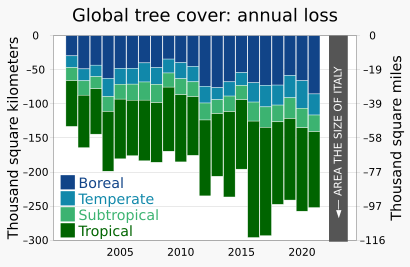Environmental degradation facts for kids
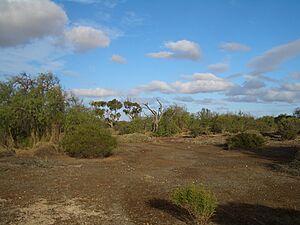
Environmental degradation means our planet's health is getting worse. This happens when important things like clean air, water, and soil are used up or become dirty. It also includes destroying ecosystems (places where living things interact), losing animal homes, and causing animals to disappear forever. Pollution is a big part of this problem too.
The United Nations sees environmental degradation as one of the top ten threats to our world. It means the environment can't provide what people and nature need anymore. This problem can be seen in many ways. When natural homes are destroyed or resources are used up, the environment suffers. Sometimes it's easy to see, like when forests are cut down. Other times, it's slower, like plastic pollution building up or greenhouse gases changing our climate. To fix this, people work on environmental protection and managing our natural resources better.
Contents
Losing Our Amazing Wildlife

Scientists believe that human activities are causing a mass extinction event, the sixth one in Earth's history. This means many plant and animal species are disappearing much faster than usual. A big reason for this is that there are more and more people on Earth, and we are using up too many natural resources.
A 2020 report from the World Wildlife Fund found that human actions have led to a 68% decrease in vertebrate (animals with backbones) wildlife since 1970. This includes things like using too many resources, population growth, and intensive farming. In 2019, a report by the UN's IPBES said that about one million species of plants and animals are at risk of disappearing. This is mainly because humans are using more land for industrial agriculture and raising livestock, and also from overfishing.
Since farming began over 11,000 years ago, humans have changed about 70% of Earth's land. The total amount of plant life has been cut in half, and land animal diversity has dropped by more than 20%. A 2021 study found that only 3% of the planet's land is still truly wild and healthy, with native animals and little human impact. Many of these untouched places are where indigenous peoples live.
Environmental damage affects over 30% of the world's land and 40% of land in developing countries, impacting 3.2 billion people globally. This loss of nature is a big worry for how people live and thrive. For example, a 2019 UN report on food and agriculture said that many species important for our food system, like pollinators (bees!) and helpful soil organisms, are declining. This is due to habitat loss, overuse, and pollution.
How Environmental Damage Affects Daily Life
When land and ecosystems are damaged, especially in rural areas, girls and women often have to work harder. They might need to travel further to find food, water, or firewood. This increases their daily tasks and makes life more difficult. Environmental problems can also affect their health and access to food and energy.
Water: Our Most Precious Resource
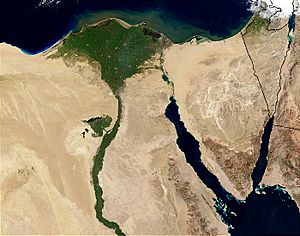
One major part of environmental degradation is the shrinking supply of fresh water on Earth. Only about 2.5% of all water on Earth is fresh water; the rest is salty. Most of this fresh water (69%) is frozen in ice caps in Antarctica and Greenland. This means only a small amount (about 30% of that 2.5%) is available for us to use. Fresh water is super important because all life on Earth depends on it. It carries nutrients, helps plants and animals grow, and shapes the land.
Most of our fresh water (95%) is used for three main things:
- About 85% is for irrigation (watering farms, golf courses, and parks).
- 6% is for home use, like bathing and watering gardens.
- 4% is for industrial uses, like cooling and washing in factories.
It's estimated that one in three people worldwide already face water shortages. Many people live in areas where there isn't enough water, or in developing countries that don't have the systems to get water from rivers and underground sources. Water scarcity is growing because of population growth, more people moving to cities, higher living standards, and climate change.
Many things pollute our water, like sewage from homes and factories, pesticides, fertilizers, oil, and chemicals. These pollutants greatly harm water quality.
Climate Change and Water Temperature
Climate change affects Earth's water supply in many ways. The average global temperature is expected to rise. This rise, along with more carbon dioxide (CO2) in the air, will impact water resources. For example, more heat means more evaporation, which can reduce the amount of water available to refill underground water supplies.
Warmer winter temperatures mean less snowpack (stored snow), which leads to less water in the summer. This is a big problem for places at mid-latitudes and in mountains that rely on melting glaciers and snow for their rivers and groundwater. As temperatures rise, glaciers will melt faster at first. But then, as glaciers shrink, less meltwater will be available each year, causing water shortages.
Rising temperatures also cause water to expand and glaciers to melt, leading to higher sea levels. This can affect fresh water near coasts. As salty ocean water moves further inland into river mouths and deltas, it makes reservoirs and underground water sources saltier. Higher sea levels can also be made worse by using too much groundwater.
A rise in air temperature also means a rise in water temperature. This is bad for water quality because warmer water is more likely to grow bacteria. It also harms ecosystems because many species are sensitive to temperature changes. Warmer water holds less dissolved oxygen, which affects the water's natural ability to clean itself.
Climate Change and Rain
A warmer world is also expected to have more overall rain. However, this can lead to more runoff, floods, and soil erosion, which can actually lower water quality. This is because the water will carry more dirt and pollutants. While we often focus on global warming, some of the biggest impacts of climate change will come from changes in rain, evaporation, runoff, and soil moisture.
Climate models show that some areas, like the tropics, might get more rain, while others, like the subtropics, might get less. This means water will be distributed unevenly around the world. Areas that get more rain might get it mostly in winter, becoming drier in summer. This uneven distribution already causes water shortages in some places.
Changes in rain affect when and how severe floods and droughts are. They also change how water flows over land and refills underground water. Plant growth and farming will be directly affected by these changes. Less rain means water tables will drop, and wetlands, rivers, and lakes will dry up. Also, the remaining water might be poor quality due to salt or pollutants from the land.
Climate change is also causing a lot of land degradation, leading to more desertification and soil that lacks nutrients. This problem is growing daily and is a major global threat. About a quarter of the world's land is now considered degraded. Land degradation affects 1.5 billion people, and 15 billion tons of fertile soil are lost every year due to human activities and climate change.
More People, More Problems

The human population is growing fast, and with it, our demand for resources. This growth is a main cause of environmental damage. Factories release smoke into the air and chemicals into water. This smoke contains harmful gases like carbon monoxide. These pollutants create layers in the atmosphere. Chemicals like CFCs have even created a hole in the ozone layer, letting in more harmful ultraviolet radiation.
The fresh water supply, already affected by climate change, must now serve more and more people. It's estimated that almost a quarter of the global population lives in areas using over 20% of their renewable water supply. Water use will rise with population, while climate change reduces water from streams and groundwater.
More people mean more water is needed for homes, farms, and industries. Farming is the biggest user of water and a major cause of environmental change and water pollution. The next 50 years will likely see the last period of rapid growth in farming, but a larger and wealthier population will demand even more food.
In the United States, more people have moved from rural areas to cities. This concentrates water demand in certain places, stressing fresh water supplies with industrial and human waste. Urbanization can lead to crowded and unsanitary living conditions, especially in developing countries. This exposes more people to diseases from dirty water and disease-carrying insects. About 79% of the world's population lives in developing countries, many without access to clean water and sewer systems.
Farming and Water
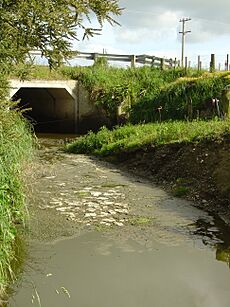
Farming depends on how much moisture is in the soil. This is directly affected by climate, especially rain and evaporation. Changes in climate, like those predicted for rain and evaporation, will directly impact soil moisture, surface runoff, and how groundwater is refilled.
In areas expected to get less rain, soil moisture could drop a lot. Most farming already needs irrigation, which uses up fresh water. Irrigation also adds salt and nutrients to areas that wouldn't normally have them. It can damage streams and rivers by building dams and removing water. Fertilizers can get into groundwater from human and animal waste. Chemicals from fertilizers can also make soil and water more acidic.
As the world's population gets wealthier, some food demands will increase more than others. For example, meat consumption is expected to double by 2050, which greatly affects the global fresh water supply. Cows need a lot of water to drink, especially in hot, dry places. Water is also needed to process meat and grow food for livestock. Animal waste can pollute fresh water, and slaughterhouses can add blood, fat, and other waste to water supplies if not managed well.
Moving water from farms to cities raises concerns about farming's future, rural communities, and food security. Climate change is also a big reason for people being forced to move from their homes. The Food and Agriculture Organization of the United Nations says that greenhouse gas emissions from raising animals are even higher than those from transportation.
Managing Our Water
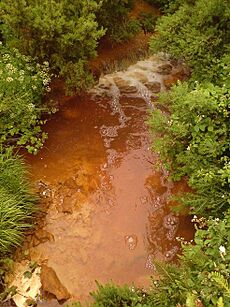
Water management is about planning and controlling water resources for all uses, focusing on both how much water there is and its quality. This involves using systems, rules, and information.
The problem of shrinking fresh water supplies has led to more efforts in water management. Water systems are often flexible, but adapting to new water conditions can be very expensive. It's important to plan ahead to avoid high costs and the need to fix water supplies. Finding new ways to reduce overall water demand is key for water sustainability.
Today's water supply systems were built based on past climate conditions, river flows, and flood patterns. Reservoirs are managed based on old records, and irrigation systems on historical temperatures and crop needs. These old guides might not work for the future. It's very important to rethink how we design, operate, and plan water systems. We also need to re-evaluate legal, technical, and economic ways to manage water resources for the future. Another idea is water privatization, where private companies manage water. This can help control service and water quality, but it has economic and cultural effects. It's important to use water wisely and sustainably, limiting overuse and pollution, and focusing on conservation.
Using More and More Resources
As the world's population keeps growing, so does our demand for natural resources. With more demand comes more damage to the environments and ecosystems where these resources are found. The United Nations predicts there could be up to 170 million more births by the year 2070. More people mean a greater need for fuel, energy, food, buildings, and water.
Losing Our Forests
As we need more land for farming and building roads, deforestation continues. Deforestation is when forests are cut down and the land is used for something else. Since the 1960s, almost half of the world's tropical forests have been destroyed. But this isn't just happening in tropical areas. Europe's forests are also being destroyed by things like livestock, insects, diseases, invasive species, and other human activities.
Many of the world's land animals and plants live in different types of forests. Cutting down these areas for our use directly reduces the number of plant and animal species native to those places. Besides destroying homes and ecosystems, losing forests also adds more CO2 to the atmosphere. Trees absorb carbon dioxide, so when we remove forests, we limit the Earth's ability to store carbon. While farming is a big reason for deforestation, removing trees also increases soil erosion, making it harder to grow crops in those areas.
See also
- Anthropocene
- Environmental change
- Environmental issues
- Ecological collapse
- Ecological crisis
- Ecologically sustainable development
- Eco-socialism
- Exploitation of natural resources
- Human impact on the environment
- I=PAT
- Restoration ecology
- United Nations Decade on Biodiversity
- United Nations Development Programme (UNDP)
- United Nations Environment Programme (UNEP)
- World Resources Institute (WRI)


